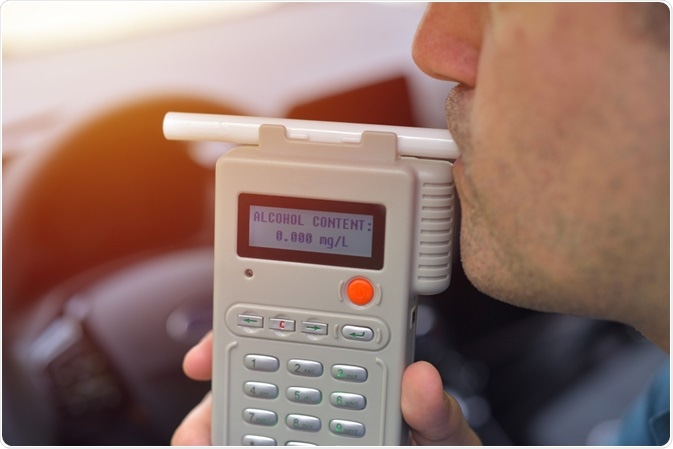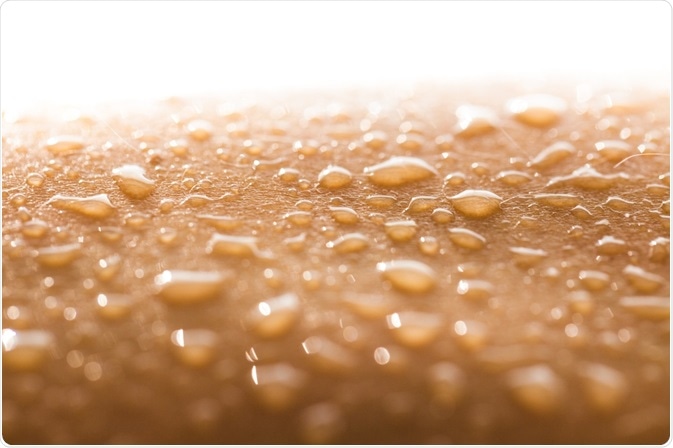Alcohol has been produced and consumed by humans for its psychoactive effects for almost 10,000 years. The amount of ethanol in the body is typically quantified by blood alcohol content (BAC); the weight of ethanol per unit volume of blood.

Image Credit: Daniel Chetroni/Shutterstock.com
At high dosages (BAC > 1 g/L), ethanol acts as a central nervous system depressant and results in adverse impacts on personal health and economic factors. The measure of BAC relies on invasive blood sampling, which is not appropriate for continuous monitoring applications. Thus, the reliable and convenient determination of BAC through non-invasive means is of significant interest for clinical, safety, and forensic applications as well as for safe recreational consumption and basic research.
Detection of Alcohol on Breath
The most common non-invasive approach for real-time determination of alcohol intoxication currently applied is the use of breath-analyzers to indirectly estimate BAC through measurement of breath alcohol concentration (BrAC).
Although this method can be applied in the field via portable breath-analyzers, the limitation is that inaccuracies can occur due to interferences from humidity, temperature, subject physiological variation, contamination from compounds present in the mouth as well as inconsistent instrument calibration. Also, the accuracy and results are largely based on purposeful action by the user, which limits continuous monitoring capability.
Alternative methods are therefore necessary to provide convenient, continuous, and accurate monitoring of alcohol. This capability could allow reliable reporting for clinical applications and promote responsible personal alcohol consumption. Hence, there is a need for developing alcohol biosensors on wearable platforms using non-invasive detection of sweat and other biofluids for continuous monitoring of BAC.
Detection of Alcohol in Sweat
New research confirms that alcohol levels in sweat correlate with blood alcohol levels. Sweat is a bodily fluid that is largely unexplored and contains many important biomarkers. The eccrine and apocrine glands produce and excrete sweat through microscale pores on the surface of the skin.
This allows for non-invasive techniques for detecting biomarkers that reflect nutrition, underlying health problems, and physiological changes in the body. Recent advances in technologies to screen the continuous biochemical monitoring have been developed using skin-interfaced wearable sensors capable of real-time in situ sweat collection and analytics.
The market for wearable diagnostic devices is projected to rapidly increase by 23 percent yearly to over $150 billion by 2026. Wearables enable users to receive personalized health data on a range of medical parameters utilizing an approach that non-invasively and seamlessly acquires data on specific digital biomarkers to monitor parameters such as physical activity and heart rate.
Wearable sensing platforms have been a focus of research and commercialization. Recent studies involve the development of a non-invasive microfluidic sensing patch that measures the ethanol levels in sweat from a person’s arm. The results correlated with the blood alcohol content measured using a commercial breathalyzer.
A significant limitation to the development of patches to monitor alcohol in sweat is that they rely on sweat produced from exercise, which is not feasible for continuously monitoring substances in sweat. Thus, it is necessary to design patches that stimulate sweat on demand using a technique called iontophoresis. This involves a small current that drives a chemical into the skin to cause local sweating that can last for days, which allows for continuous measurement.
The utilization of electrochemical biosensors in these wearable sensing platforms has been a major topic of research, which can involve the introduction of a lactate amperometric biosensor for epidermal sweat based on immobilized lactate oxidase. Wearable sensing devices have been designed to detect target analytes in sampled biofluids such as sweat, which can be correlated with levels of alcohol in the blood.
Thus, the monitoring of alcohol concentrations in sweat could be achieved without requiring invasive blood sampling, which allows for a real-time measure of alcohol intoxication. The development of alcohol sensors targeting detection in sweat has been of keen interest to researchers due to its social and economic impact.
Hence, the large impact a wearable device might have on society has led to the generation of epidermal electrochemical biosensors with the functionality and practicality of not compromising wearer comfort. Several wearable sensing platforms have been designed recently for the detection of alcohol, focusing primarily on monitoring sweat.
Also, wearable alcohol detection methods should incorporate the detection of other biofluids, such as tears and saliva, as well as focus on the improvement of repeatability and improved stability for extended monitoring periods.
Wearable alcohol detection devices from sweat show promising capabilities as long as the correct method validation steps are in place to ensure large-scale on-body trials that correlate with concurrent changes in BAC. Furthermore, such wearable devices would have additional commercial appeal if they were integrated into clothing or fashion accessories for effective incorporation into the life of a person.

Image Credit: Billion Photos/Shutterstock.com
References
- McGovern PE, Zhang J, Tang J, Zhang Z, Hall GR, Moreau RA, Nuñez A, Butrym ED, Richards MP, Wang CS, Cheng G, Zhao Z, Wang C (December 2004). "Fermented beverages of pre-and proto-historic China". Proceedings of the National Academy of Sciences of the United States of America. 101 (51): 17593–8
- Hendler RA, Ramchandani VA, Gilman J, Hommer DW (2013). "Stimulant and sedative effects of alcohol". Current Topics in Behavioral Neurosciences. 13: 489–509.
- Wade, J. Wearable Technology Statistics and Trends 2018. Smart Insights.
- Piwek, L.; Ellis, D.A.; Andrews, S.; Joinson, A. The Rise of Consumer Health Wearables: Promises and Barriers. PLoS Med. 2016, 13
- Thungon PD, Kakoti A, Ngashangva L, Goswami P: Advances in developing rapid, reliable, and portable detection systems for alcohol. Biosens. Bioelectron 2017, 97: 83–99.
- Simpson G: Accuracy and precision of breath-alcohol measurements for a random subject in the postabsorptive state. Clin. Chem 1987, 33: 261–268.
- Worner TM, Prabakaran J: The accuracy of breath alcohol analysis using the breathalyzer. Alcohol Alcoholism 1985, 20: 349–350.
- Ali SS, Wilson MP, Castillo EM, Witucki P, Simmons TT, Vilke GM: Common hand sanitizer may distort readings of breathalyzer tests in the absence of acute intoxication. Acad. Emerg. Med 2013, 20: 212–215.
- Jia WZ, Bandodkar AJ, Valdes-Ramirez G, Windmiller JR, Yang ZJ, Ramirez J, Chan G, Wang J: Electrochemical tattoo biosensors for real-time noninvasive lactate monitoring in human perspiration. Anal. Chem 2013, 85: 6553–6560.
- Windmiller JR, Wang J: Wearable electrochemical sensors and biosensors: A review. Electroanalysis 2013, 25: 29–46.